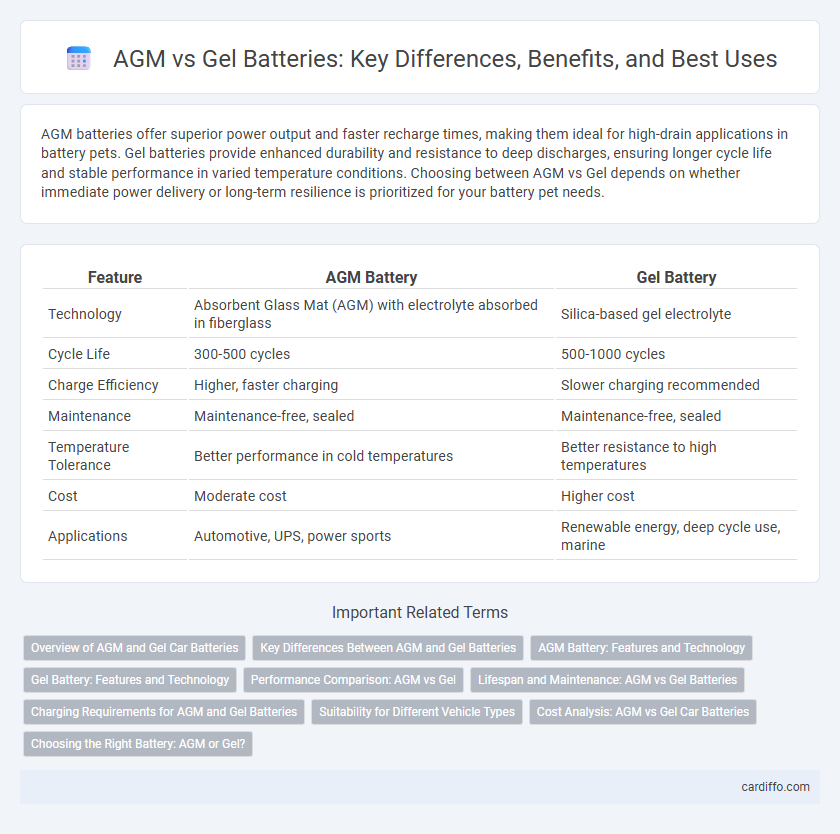AGM batteries offer superior power output and faster recharge times, making them ideal for high-drain applications in battery pets. Gel batteries provide enhanced durability and resistance to deep discharges, ensuring longer cycle life and stable performance in varied temperature conditions. Choosing between AGM vs Gel depends on whether immediate power delivery or long-term resilience is prioritized for your battery pet needs.
Table of Comparison
| Feature | AGM Battery | Gel Battery |
|---|---|---|
| Technology | Absorbent Glass Mat (AGM) with electrolyte absorbed in fiberglass | Silica-based gel electrolyte |
| Cycle Life | 300-500 cycles | 500-1000 cycles |
| Charge Efficiency | Higher, faster charging | Slower charging recommended |
| Maintenance | Maintenance-free, sealed | Maintenance-free, sealed |
| Temperature Tolerance | Better performance in cold temperatures | Better resistance to high temperatures |
| Cost | Moderate cost | Higher cost |
| Applications | Automotive, UPS, power sports | Renewable energy, deep cycle use, marine |
Overview of AGM and Gel Car Batteries
AGM (Absorbent Glass Mat) batteries utilize a fiberglass mat to absorb electrolyte, providing superior vibration resistance and faster recharge times, making them ideal for high-performance and start-stop vehicles. Gel batteries contain a silica-based gel electrolyte, offering excellent deep discharge capabilities and enhanced resistance to extreme temperatures, suitable for off-road and marine applications. Both types are maintenance-free, sealed lead-acid batteries designed to minimize electrolyte leakage and improve safety compared to traditional flooded batteries.
Key Differences Between AGM and Gel Batteries
AGM batteries utilize absorbed glass mat technology, offering faster charging and superior cold-weather performance, while Gel batteries use silica-thickened electrolyte for enhanced resistance to deep discharge and better heat tolerance. AGM batteries have lower internal resistance and higher cranking power, making them ideal for starting applications, whereas Gel batteries provide longer cycle life and are optimal for deep cycle use in renewable energy systems. Both types are sealed, maintenance-free, and resistant to vibration, but AGM batteries generally deliver better high-current output and Gel batteries ensure stability in extreme temperature conditions.
AGM Battery: Features and Technology
AGM (Absorbent Glass Mat) batteries feature a unique design where the electrolyte is absorbed into fiberglass mats, enabling spill-proof operation and enhanced vibration resistance. Their advanced valve-regulated lead-acid (VRLA) technology allows for efficient recombination of gases, resulting in low maintenance and reduced water loss. AGM batteries provide superior cold-cranking performance, high charge acceptance, and longer cycle life compared to traditional lead-acid batteries, making them ideal for automotive and deep cycle applications.
Gel Battery: Features and Technology
Gel batteries utilize a silica-based electrolyte that turns the acid into a thick gel, enhancing spill resistance and reducing maintenance requirements. Their advanced valve-regulated lead-acid (VRLA) design offers superior performance in deep cycling and extreme temperature conditions compared to traditional AGM batteries. This technology ensures longer lifespan and better durability, making gel batteries ideal for solar energy storage and off-grid applications.
Performance Comparison: AGM vs Gel
AGM batteries deliver higher cold-cranking amps and faster recharge rates, making them ideal for high-drain applications and quick recovery. Gel batteries provide superior deep-cycle performance, longer service life, and better resistance to vibration and extreme temperatures. Performance preferences depend on usage scenarios, with AGM favored for power bursts and Gel preferred for sustained, deep discharge cycles.
Lifespan and Maintenance: AGM vs Gel Batteries
AGM batteries typically offer a lifespan of 4 to 7 years with minimal maintenance requirements due to their sealed design and resistance to vibration. Gel batteries, known for their superior deep discharge recovery, can last up to 5 to 7 years but require careful charging to prevent gel electrolyte damage. Both types provide maintenance-free operation, though AGM batteries generally withstand harsher conditions better, making them more durable for frequent cycling and harsher environments.
Charging Requirements for AGM and Gel Batteries
AGM batteries require a controlled charging voltage typically between 13.6 to 14.4 volts to prevent overcharging and extend battery life. Gel batteries need lower and more precise charging voltages, usually around 13.8 to 14.1 volts, to avoid damaging the silica gel electrolyte. Proper charging profiles, including reduced current and temperature compensation, are critical for maintaining optimal performance in both AGM and Gel battery types.
Suitability for Different Vehicle Types
AGM batteries excel in high-performance vehicles and trucks requiring strong starting power and vibration resistance, making them ideal for off-road and heavy-duty applications. Gel batteries perform better in deep-cycle uses and are well-suited for recreational vehicles, motorcycles, and marine applications where prolonged, slow discharge and resistance to spillage are critical. Choosing between AGM and Gel batteries depends on the vehicle's power demands, operating conditions, and maintenance preferences.
Cost Analysis: AGM vs Gel Car Batteries
AGM car batteries typically cost between $120 and $200, offering a balance of affordability and performance, while gel batteries range from $150 to $250, reflecting their advanced deep-cycle capabilities and longer lifespan. Maintenance costs for AGM batteries are generally lower due to their sealed design, reducing the need for electrolyte replenishment, whereas gel batteries, despite higher upfront costs, excel in stability and durability, potentially lowering replacement frequency. Evaluating total cost of ownership reveals AGM batteries as cost-effective for standard use, while gel batteries provide greater value for heavy-duty or off-road applications.
Choosing the Right Battery: AGM or Gel?
Choosing the right battery between AGM and Gel depends on your specific power needs and environmental conditions. AGM batteries offer superior cold-weather performance and faster charging, making them ideal for high-drain applications and vehicles with advanced electronics. Gel batteries provide excellent deep discharge capabilities and greater resistance to vibration, which suits off-grid solar systems and marine use where longevity and maintenance-free operation are critical.
AGM vs Gel Infographic

 cardiffo.com
cardiffo.com